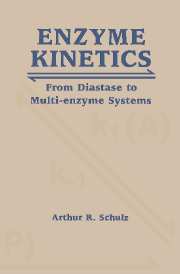Book contents
- Frontmatter
- Contents
- Preface
- Part One Basic steady state enzyme kinetics
- Part Two Enzyme reaction sequence
- 5 Multi-reactant enzymic reactions
- 6 Analysis of multi-reactant enzyme kinetics
- 7 Prediction of reaction sequence
- 8 Enzyme-catalyzed isotopic exchange
- 9 Kinetic isotope effect on steady state parameters
- 10 The effect of pH on enzyme kinetics
- Part Three Non-hyperbolic enzyme kinetics
- Part Four Control of multi-enzyme systems
- Part Five Solutions To problems
- Author index
- Subject index
7 - Prediction of reaction sequence
Published online by Cambridge University Press: 23 November 2009
- Frontmatter
- Contents
- Preface
- Part One Basic steady state enzyme kinetics
- Part Two Enzyme reaction sequence
- 5 Multi-reactant enzymic reactions
- 6 Analysis of multi-reactant enzyme kinetics
- 7 Prediction of reaction sequence
- 8 Enzyme-catalyzed isotopic exchange
- 9 Kinetic isotope effect on steady state parameters
- 10 The effect of pH on enzyme kinetics
- Part Three Non-hyperbolic enzyme kinetics
- Part Four Control of multi-enzyme systems
- Part Five Solutions To problems
- Author index
- Subject index
Summary
The methods discussed in previous chapters provide for the derivation of rate equations of even complex enzyme-catalyzed reactions. It is true that, if the reaction sequence of the enzymic reaction is highly random, a computer-based derivation is the only feasible alternative, but the algorithm described in chapter 5 can be incorporated into a computer-based procedure. However, there is a problem with the approach that has been followed to this point. The underlying presumption for each enzymic reaction has been that there is a known reaction sequence. If the reaction sequence is known, regardless of how complex that sequence may be, it is possible to derive an appropriate rate equation. Herein lies the problem! When one initiates an investigation of the kinetic behavior of an enzyme, the reaction sequence is not known, and the presumption of a plausible reaction sequence is the worst of the possible approaches to the investigation.
The enzyme kineticist and the mystery novel
The unravelling of the reaction sequence of an enzymic reaction is completely analogous to the unravelling of a crime in a mystery novel. The study of the kinetic behavior of an enzyme has all the challenge and intrigue of a well-written mystery novel! While instinct may be of some small value to the detective who would determine the kinetic behavior of an enzyme or solve a murder mystery, instinct can prove to be a fickle ally. Precise investigative work requires the combination of asking the proper questions at the proper time and a sagacious interpretation of the answers received. The enzyme kineticist has only one “witness” to whom the questions can be addressed, and that is the enzyme itself.
Information
- Type
- Chapter
- Information
- Enzyme KineticsFrom Diastase to Multi-enzyme Systems, pp. 92 - 102Publisher: Cambridge University PressPrint publication year: 1994
